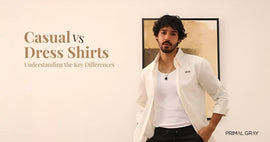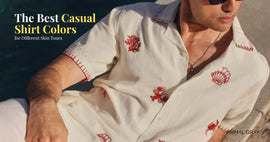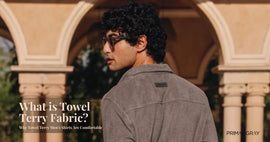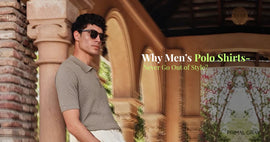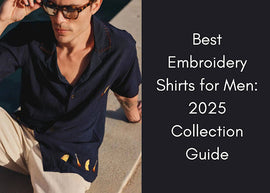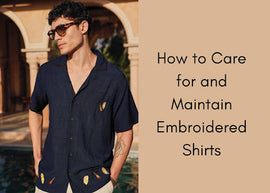The Best Fabrics for Summer Casual Shirts 2025
Posted by Primal Gray
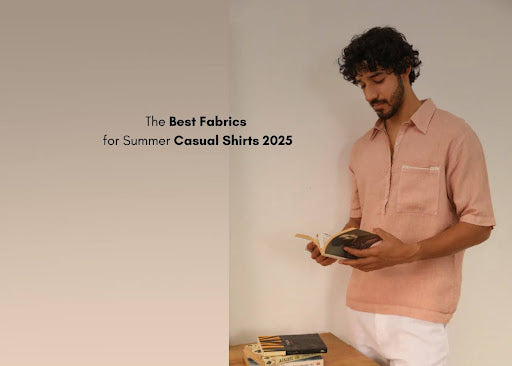
Let’s face it, dressing well in summer is less about trends and more about survival. Amidst the humidity, heatwaves, and barely-there breezes, your shirt choice can either make your day or completely ruin it. So if you’re sweating it out in layers that feel like plastic, it’s time to rethink your wardrobe from the fabric up.
Picking the right material isn’t just about comfort. It is about how the shirt moves, breathes, and works with your body throughout the day. The good news? You don’t need a dozen options. You just need a few good ones that actually get the job done.
In this guide, we break down the best summer shirt materials for 2025. Think practical, lightweight, and wearable, the kind of fabrics that feel like a breeze even when the air isn’t moving.
Linen for the Sweaty Summer
Nothing beats linen when it comes to summer shirt fabrics. It’s airy, dries quickly, and actually looks better when it is slightly wrinkled. An absolute blessing in Indian summers where nothing stays crisp anyway.
Linen shirts drape naturally and don’t cling, making them ideal for sticky, humid days. Whether you're wearing a kimono silhouette or a relaxed button-down, linen is your safest bet for breathability and effortless style.
If you're shopping for casual shirts for summer, make sure at least one of them is a solid linen piece. Pro tip: neutral shades like beige, ivory, and olive hide wrinkles best and pair easily with everything else in your wardrobe.
The Evergreen Cotton
Cotton’s reputation for comfort isn’t hyped, it’s earned. It’s one of the most reliable light fabrics for summer shirts and works well whether you’re dressing up or keeping it casual.
Look for lightweight cotton, poplin, or voile options. Heavier cottons can feel stiff and trap heat, but finely woven ones offer breathability without losing shape. If you’re looking for something that's easy to maintain and gentle on the skin, cotton shirts are always a solid choice.
Cotton also blends well with other fabrics (like linen or modal), which can give you the structure of one and the softness of another. That’s a win.
Rayon and Modal for the Silky Without the Sweat
If you’re someone who wants your shirts to feel soft but never sticky, rayon or modal blends are worth considering. These are semi-synthetic fibres made from natural sources like wood pulp and are designed to be breathable, smooth, and great for draping.
They feel cool to the touch and work beautifully in casual shirts for summer when you’re leaning into slightly dressier styles, imagine band-collar shirts or relaxed fits with subtle detailing.
Rayon shirts absorb moisture well but tend to wrinkle more easily, so they work best when you want that "effortless but polished" vibe without putting in much effort at all.
The Denim-Like Chambray
If you like the look of denim but hate the weight of it in the heat, chambray is your answer. It looks like denim but is woven differently, making it lighter, softer, and more breathable.
It’s a great choice for those who like structure in their shirts but still want something summer-friendly. You can style chambray shirts with neutral chinos, linen trousers, or even dark denim for that double-layered denim look without overheating.
Among the best summer shirt materials, chambray strikes a balance between casual cool and functionality, making it perfect for wearing round the clock.
The Surprisingly Stylish Seersucker
Seersucker may not be as common as linen or cotton, but it deserves more credit. Its signature puckered texture keeps the fabric slightly off your skin, creating natural airflow, exactly what you need on sweaty afternoons.
This makes it one of the most underrated summer shirt fabrics. It also rarely needs ironing and dries fast, which means it scores high in both form and function.
Try seersucker in light pastel shades or subtle stripes for a shirt that feels as good as it looks. It’s casual, breathable, and holds up beautifully during long days out.
Linen-Cotton, Cotton-Rayon, Modal Mixes because Sometimes Blends Work
Blended fabrics are where practicality meets performance. The right mix can give you the breathability of natural fibres with the softness, structure, or durability of synthetics.
Linen-cotton blends are lighter than pure cotton but less wrinkle-prone than pure linen. Cotton-rayon offers softness without the sticky feel. Modal blends drape well and are great for modern fits or drapey silhouettes like kimono shirts.
In short, the future of summer shirt fabrics 2025 is flexible and blends are proof that you don’t have to pick between comfort and structure anymore.
What your Fabric Shoplist Should Look For in 2025
- Weight: Go for fabrics under 150 gsm for breathable comfort
-
Weave: Tighter weaves are less breathable. Stick to open weaves for airflow
-
Texture: Light crinkles and slubs help fabrics lift off the skin and stay breezy
-
Feel: Run your hand over the shirt. If it already feels warm to touch, skip it
-
Washability: The best fabrics aren’t just comfortable they are easy to care for too
Comfort is the New Dress Code
The truth is, the way we dress in 2025 is different. Style doesn’t mean sacrificing comfort anymore and the smartest outfits start with the right fabrics.
From classics like linen and cotton to newer blends and textures, there’s no shortage of options. The trick is choosing what feels right on your skin and fits into your everyday life. Whether you’re heading to work, lounging at home, or grabbing coffee, your shirt should move with you, not against you.
So next time you’re shopping for casual shirts for summer, don’t just look at the print or price, feel the fabric. Ask how it’ll hold up through heat, movement, and multiple wears. That’s where real style begins.
And if you’re looking for easy-to-wear, well-constructed pieces made from the best summer shirt fabrics 2025, check out the latest range from Primal Gray. Their focus on high-quality natural fibres makes summer dressing a whole lot cooler, quite literally.
Frequently Asked Questions
1. What are the best fabrics for summer casual shirts?
The best fabrics for summer casual shirts in 2025 are linen, lightweight cotton, rayon, modal, chambray, and seersucker. These materials are chosen for their breathability, ability to wick moisture, and soft hand-feel. Linen excels in heat and humidity, while cotton offers versatility. Modal and rayon give you a smooth drape, and chambray or seersucker add texture without sacrificing comfort. Stick to these for stylish, sweat-proof comfort.
2. What is the most breathable fabric for summer shirts?
Linen wins hands down as the most breathable fabric for summer shirts. Its loose weave and natural fibers allow maximum airflow, keeping you cool even when the temperature spikes. It also dries fast and doesn’t trap heat, which makes it ideal for hot, sticky days. If you want that "barely there" feel in high heat, linen is your best bet.
3. Which fabric is best for casual shirts in hot weather?
For hot weather, cotton and linen remain unbeatable classics. Linen is ideal for those long humid days, while fine cottons like poplin or voile feel light yet structured. If you’re after a more drapey or polished style, modal or rayon blends are excellent too. Each fabric offers a unique balance of breathability, comfort, and ease of movement, essential for surviving summer in style.
4. How do I choose the best fabric for a summer shirt?
Start by checking the fabric weight, anything under 150 gsm is ideal. Then look at the weave; looser or open weaves allow better air circulation. Feel the texture, natural slubs or puckered fabrics (like seersucker) sit off the skin and feel breezy. Lastly, think about maintenance. A good summer fabric should be easy to wash, quick to dry, and comfortable from the first wear.
5. What is the most comfortable fabric for summer shirts?
Comfort is personal, but for most people, lightweight cotton and modal blends top the list. Cotton feels soft and familiar, while modal adds a smooth, almost silk-like touch without the cling. Linen is also extremely comfortable once you embrace its relaxed look and natural wrinkles. Ultimately, comfort comes down to how the fabric handles heat, sweat, and your daily movement, and these fabrics check all the boxes.

